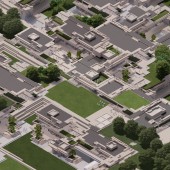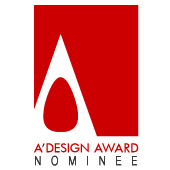Diffusive Habitats Mechatronic Architecture System by Sergio Mutis |
Home > Winners > #145846 |
 |
|
||||
| DESIGN DETAILS | |||||
| DESIGN NAME: Diffusive Habitats PRIMARY FUNCTION: Mechatronic Architecture System INSPIRATION: Unlike other crafts, arts, and industries, architecture has not seen significant developments during the upheaval of the digital revolution. Traditional praxis continues to produce buildings incapable of substantial programmatic flexibility, that become obsolete within the ever-accelerating change of the times, and quickly end up in queue for demolition. Diffusive Habitats challenges this unsustainable practice, instrumentalizing its technological juncture in the lookout for renewed solutions. UNIQUE PROPERTIES / PROJECT DESCRIPTION: Diffusive Habitats (DH) is a resilient architectural system that builds upon the juncture of distributed robotics, reinforcement learning, and digital platforms to reimagine the way architecture is conceived and inhabited. Challenging traditional praxis, the project embraces constant spatial reconfiguration and distributed ownership. And, via the interplay of applied transdisciplinary research, DH critically explores a spatial system capable of self-assessment, organization, and improvement. OPERATION / FLOW / INTERACTION: Diffusive Habitats operates via an online platform facilitating plot search, habitat crowdfunding, collaborative design, and spatial reconfiguration. Behind its intuitive interface, the platform employs sophisticated algorithms to organize space based on inhabitant requirements, structural integrity, and environmental optimization. With it, a community is able to design their ideal habitat, see it constructed by robots, and adjust it to account for changing individual and collective needs. PROJECT DURATION AND LOCATION: The project was developed as part of the Architectural Design M.Arch. at UCL in London, UK. It started in 2021 and culminated in late 2022 at Bartlett B-Pro Show Expo, where it received the Bartlett AD Gold Medal. The case-study is located in Brixton, London, and the design team comes from India, Colombia, the US, and Greece. FITS BEST INTO CATEGORY: Architecture, Building and Structure Design |
PRODUCTION / REALIZATION TECHNOLOGY: The DH system consists of multiple correlated elements that were heuristically prototyped, tested, and redesigned. Its space generation platform was scripted in C-sharp for Unity3D with the ML Agents U3D reinforcement learning framework. Laminated plywood prototypes were CNC-milled and assembled with friction joints. 3D-printed PLA robotic prototypes were developed with a Unity3D digital twin environment, wireless Raspberry Pi communication, Dynamixel AX-12A motors, and Optitrack motion capture. SPECIFICATIONS / TECHNICAL PROPERTIES: Robot Prototypes 3.0. Dimensions: Width 100mm x Depth 100mm x Height 280mm. Composition: 3D-Printed recycled plastic (PLA). Weight: 420g. Parts: 5 links of 3D-printed PLA, 8 neodymium magnets 20dx3, 4 Dynamixel AX-12A motors, 1 LiPo 3cell Battery, 1 U2D2 Power Hub, 1 Raspberry Pi Zero. // Material Prototypes 3.0. Standard Dimensions: Width 140mm x Depth 420mm x Height 140mm. Standard Weight: 477g. Composition: CNC-milled laminated plywood with embedded 3D-printed PLA connection interfaces. TAGS: Living Architecture, Distributed Mechatronics, Reinforcement Learning, Multi-Agent Systems, Generative Architecture RESEARCH ABSTRACT: Diffusive Habitats employs systematic heuristic research, with reinforcement learning and self-play frameworks for intelligence development. The main research objective was to explore an architectural system capable of self-organization, assessment, and improvement, that would embrace technological advancements to reimagine how we conceive and inhabit spaces. To do so, the project adopted a method of small attainable mechatronic, computational, material, and intelligence milestones that were quickly designed, tested, and analyzed to inform an upcoming iteration. Data collection and analysis included: weight, task success rate, and cost for robotic design / multi-requirement satisfaction for computational generative design / weight, open source fabrication index, and sustainability for material research / task success rate, speed, and energetic efficiency for robotic intelligence. Tests were carried out via simulations in Unity and C# for computational algorithms and robotic intelligence, and via physical tests for mechatronic and material development. Initial results were systematically improved by following iterations leading up to a mechatronic design with diverse capabilities (particularly while collaborating), a computational framework that could organize space under numerous requirements far better than any one designer, a material unit that proved capable of forming multiform structures (though not yet capable of being employed in buildings over 2 stories high), and a robotic intelligence that could calculate, optimize, and execute large reconfiguration tasks. The project still requires development to be thoroughly applied in architectural practice. Yet, within the constraints of a 1-year Master's degree project, it was considered a vast success and will be used to attract interest and funds to further the research. The effects of this investigation range from avoiding demolition and boosting the sustainability of the built environment, to transforming rigid urban dwellings into flexible hubs for the ever-accelerating change of our times. Altogether, this research explores a radically novel way of living that could be a widespread reality in the future, or allow for new conversations to occur that will ultimately improve the way we live. CHALLENGE: Besides technological and transdisciplinary challenges, the shift in authorship paradigm was perhaps the greatest obstacle in the development of the project. Rather than the desires of individual designers, this research required a heuristic process of trial and error, where the design was the result of cascading iterations of parameter optimization. Once the team embraced that fundamental idea, the once slow and erratic project advanced swiftly beyond its initial research objectives. ADDED DATE: 2022-10-06 22:47:06 TEAM MEMBERS (4) : Sergio Mutis, Eric Hughes, Faizunsha Ibrahim Ghousiaa and Garyfallia Papoutsi. IMAGE CREDITS: Image #1: Creator Eric Hughes, DH Little Girl Rendering, 2022 Image #2: Creator Sergio Mutis, DH Reinforcement Training Arena, 2022 Image #3: Creator Eric Hughes, DH Skylight Rendering, 2022 Image #4: Creator Sergio Mutis, DH Robotic Reconfiguration Studies, 2022 Image #5: Creator Eric Hughes, DH Speculative Urbanism, 2022 |
||||
| Visit the following page to learn more: https://bpro2022.bartlettarchucl.com/rc3 |
|||||
| AWARD DETAILS | |
 |
Diffusive Habitats Mechatronic Architecture System by Sergio Mutis is Winner in Generative, Algorithmic, Parametric and AI-Assisted Design Category, 2022 - 2023.· Read the interview with designer Sergio Mutis for design Diffusive Habitats here.· Press Members: Login or Register to request an exclusive interview with Sergio Mutis. · Click here to register inorder to view the profile and other works by Sergio Mutis. |
| SOCIAL |
| + Add to Likes / Favorites | Send to My Email | Comment | Testimonials | View Press-Release | Press Kit |
Did you like Sergio Mutis' Generative Design?
You will most likely enjoy other award winning generative design as well.
Click here to view more Award Winning Generative Design.








